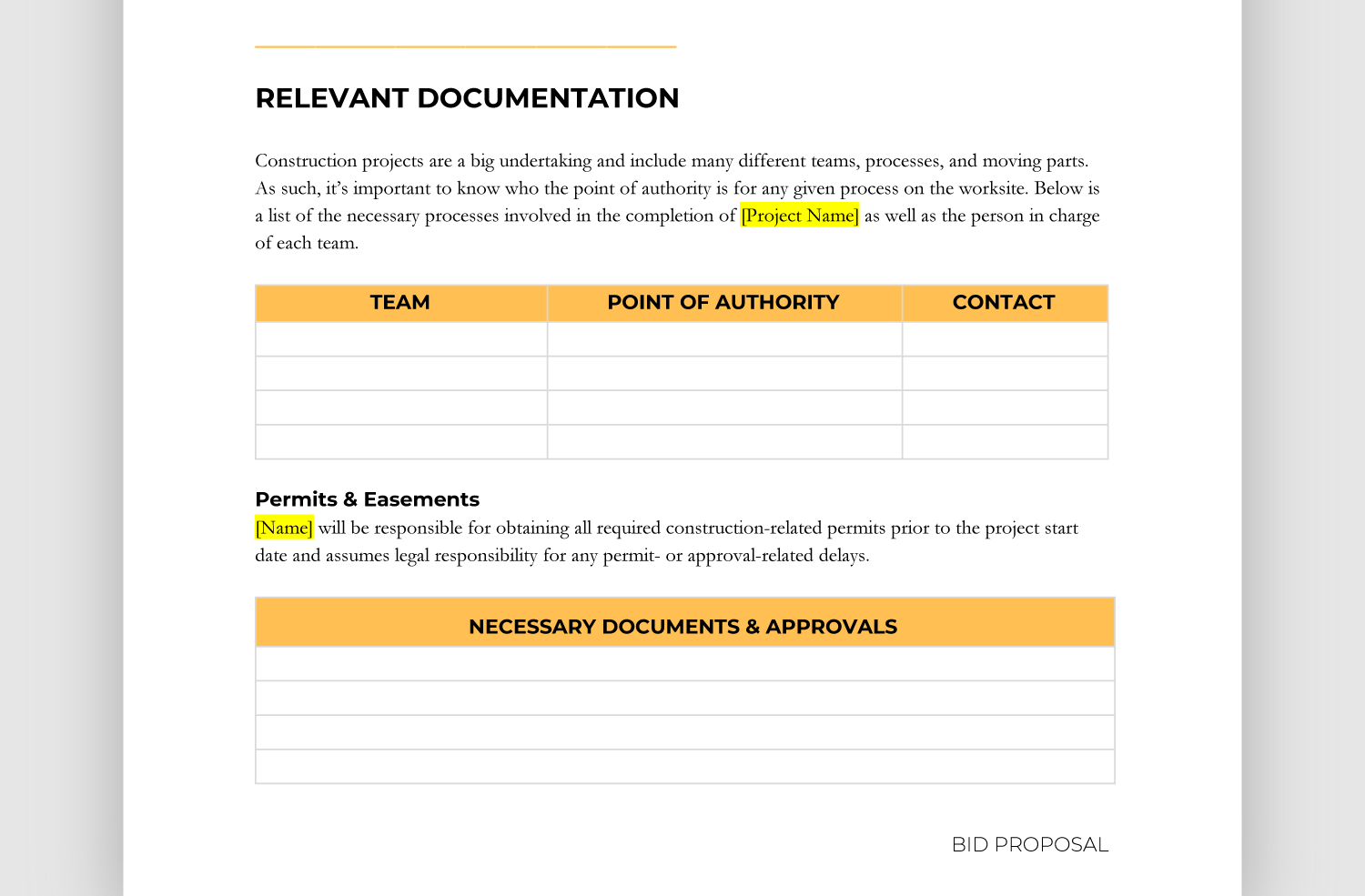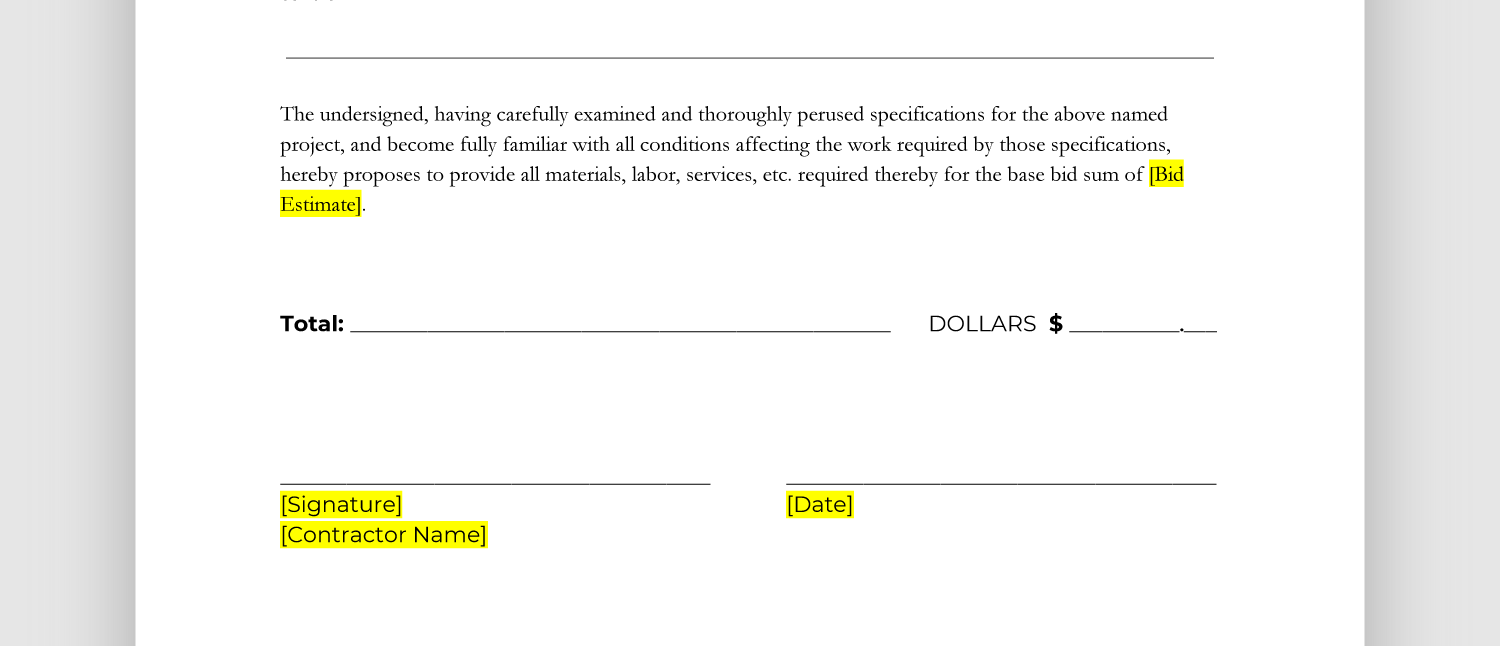Anyone who’s ever worked on a construction project has likely been part of the bidding process. Whether you’re the one soliciting proposals or you’re prepping bids yourself, if you’re in a contract-heavy industry, you know just how important the bid document is. Not only does the proposal bid determine who gets the contract for a project, but it’s also used throughout the construction process as a reference tool, safety guide, contact sheet, and rule book. It acts as the centralizing resource connecting the many different teams and individuals on the worksite at any given time.
A well-written construction bid can simplify a project, save both parties money, and speed up a work schedule. A poorly assembled construction bid, on the other hand, can be a disaster.
That’s why it’s essential that a project manager optimizes the structure they use to prepare their construction bids. Using a standard template across projects will ensure that all of your employees are using best practices in their bidding process. The easiest way to do this is to use a downloadable construction bid template. This will prevent you from forgetting key information or putting things in the wrong place on your construction bid.
What Is a Construction Bid?
A construction bid is a document that a developer submits to a potential customer detailing the estimated cost, scope, and work schedule of a building project in an effort to “win” the contract against competing developers. The customer solicits construction bids from various developers and evaluates the information provided in order to choose the developer they believe will do the best job for the most appropriate price.
A well-written construction bid is essential, as it can make or break whether or not a builder is hired for a project. A builder with the lowest cost estimate and fastest work schedule still won’t win the contract if they don’t accurately provide that information to the customer. And if you do somehow manage to secure a contract with a poorly written construction bid, it can cause mistakes, miscommunication, and waste down the line.
Best Practices for Your Construction Bid
To prepare a construction bid that is effective for your company, here are some best practices to follow.
Use Simplified, Standardized Terms
Especially when bidding on a large, multi-part project, it’s easy to get lost in the details and your bid proposal can end up being confusing. This can result in your company losing the contract to a firm whose bid proposal was easier to understand.
To avoid this, make sure you use simplified language and, in cases where you must use industry terms, consider utilizing a vocabulary like MasterFormat. This will help the project owner get a clear idea of the services and quality you’re offering.
Consider Adding Appendices
A bid document includes several sections that have the potential to be very complicated, like a full estimated budget and breakdown of necessary labor. Rather than attempting to squeeze all of this information into the body of your proposal, consider including a streamlined version of this information and then referring the reader to a separate budget document included with the proposal.
Make Your Template Easily Available
Due to how dynamic the construction industry is, it’s a given that each project will have slightly different requirements when it comes to preparing a bid document. To simplify the preparation process, make your bid template available across all of the teams at your firm so that they’re able to download and modify it according to their client’s needs. Since you’ll likely be working with subcontractors outside of your firm, make sure the file is accessible to people outside of your company as well.
Download a Customizable Construction Bid Template
This template includes all of the information necessary to prepare a comprehensive construction bid. You can print it and fill it out by hand or download a copy of the document via Microsoft Word or Google Docs and customize it according to your individual needs.
What Goes on a Construction Bid Form?
Though individual construction bids and templates may vary, they all must contain the same key elements.
1. The Basics
At the top of the document, all of the contact information for both the construction company and the potential customer should be listed. This includes names, addresses, and signatures for all parties involved. Also be sure to list the name and address of the project itself.
2. Project Scope
Before getting into any pricing details, the construction bid should first lay out the scope of the project. It’s important to get as detailed as possible here, highlighting all of the services you’re proposing to provide. Write out the grade of the work, the proposed schedule, quality, materials, and any other features necessary for the completion of the project.
This is also where you should include client expectations, like provision of worksite equipment, additional crew needs, process for removing trash, etc. Be sure to clearly articulate responsibility for any task that may not have a clear owner, like who is in charge of cleaning the worksite after the project is completed, or whether you plan to subcontract a cleaning company.
Be sure to also document all worksite and procedural expectations here, like who is allowed on the worksite, what safety gear is required for visitors, and what plans are in place to protect children, seniors, and pets who may live or work near the worksite.
3. Existing Conditions
You need to perform a preliminary site assessment before preparing your bid document, and the resulting proposal should include a documentation of the existing conditions at the worksite. Be sure to include the necessary actions taken to remediate each condition as well as which party is responsible for each task.
You should also include a clause detailing how you plan to handle any existing conditions that are discovered after the project begins, and who will determine the scope and cost of the necessary added remediations.
4. Cost
This is where you’ll provide the customer with a cost estimate for the entire project, broken down into subsections such as materials and labor. This section should also detail the costs that would incur should the project go over scope, in order to lay out clear expectations up front.
5. Terms of Payment
Many people include a cost estimate and forget to also detail the terms of payment — that is, the manner in which and when they expect to be paid. It’s unlikely that the customer will be willing to pay you all at once, so write out a list of milestones for the project and what percentage of the total should be paid at that point.
6. Relevant Documentation
Construction projects are huge and consist of many sub-projects that are managed by different authorities. It’s important to lay out in your construction bid exactly what those sub-projects are and who has authority over them.
This will eliminate confusion later on by making clear exactly who is in charge of each project, as well as who has the legal authority to sign relevant paperwork and enter into legally binding commitments during the project.
7. Work Schedule
Your work schedule should be more than just when the project will begin and end. This section should also include the date that the contractor will receive approval to begin work on the project. This is also where you should detail the extent to which you will assume liability for delays caused by events beyond your control, like permit approvals or poor weather.
Be sure to also differentiate between working days and calendar days, and don’t forget to factor in supplier lead times, permit or zoning approval periods, and other third-party processes that could delay your schedule.
8. Formal Bid & Signatures
Finally, the bid proposal is not complete without a formal statement of intent to provide services for the project as well as a bid estimate and signatures. If you’re the sole owner of your company, you can sign the document alone, but if you’re working together with a co-owner or manager you should have them sign the document as well.
What a Good Bid Template Can Do for You
When your construction bid is well-prepared, well-formatted, and well-designed, it’s easy to see the effect it has on your bid success as well as the efficiency of your internal team. Project owners are more likely to trust a firm whose documentation process is well-organized, giving you an edge over the competition. When your proposal is well-prepared, it will be that much easier for your potential client to see the value your company offers to their project.
Additionally, a well-prepared bidding document can help prevent mistakes and miscommunications down the line. With a clear scope and a detailed documentation of requirements, your project will require fewer change orders down the line, saving your clients money and saving your company time.
Disclaimer
Any articles, templates, or information provided by BigRentz on the website are for reference only. While we strive to keep the information up to date and correct, we make no representations or warranties of any kind, express or implied, about the completeness, accuracy, reliability, suitability, or availability with respect to the website or the information, articles, templates, or related graphics contained on the website. Any reliance you place on such information is therefore strictly at your own risk.


















